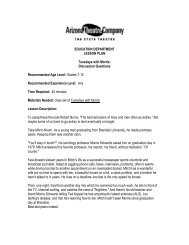Freud's Last Session (PDF) - Arizona Theatre Company
Freud's Last Session (PDF) - Arizona Theatre Company
Freud's Last Session (PDF) - Arizona Theatre Company
- No tags were found...
You also want an ePaper? Increase the reach of your titles
YUMPU automatically turns print PDFs into web optimized ePapers that Google loves.
TABLE OF CONTENTSABOUT ATC . 1INTRODUCTION TO THE PLAY. 2MEET THE CREATORS. 2MEET THE CHARACTERS. 3INTERVIEW WITH THE DIRECTOR. 5REFLECTIONS FROM THE REHEARSAL ROOM. 6FREUD, DARWIN, AND PSYCHOANALYSIS. 8LEWIS AND NARNIA . 9THE INKLINGS. 10FREUD’S DOGS. 10HISTORICAL TIMELINE. 11FREUD VS. LEWIS: A BATTLE OF QUOTES. 13DISCUSSION QUESTIONS AND ACTIVITIES . 14Freud’s <strong>Last</strong> <strong>Session</strong> Play Guide written and compiled by Katherine Monberg, ATC Literary Assistant, and Karen Altree Piemme, SJRDirector of Outreach. Discussion questions and activities provided by April Jackson, Associate Education Manager, Amber Tibbitts andBryanna Patrick, Education Associates.Support for ATC’s education and community programming has been provided by:APS<strong>Arizona</strong> Commission on the ArtsBank of America FoundationBlue Cross Blue Shield <strong>Arizona</strong>City Of GlendaleCommunity Foundation for Southern <strong>Arizona</strong>Cox CharitiesDowntown Tucson PartnershipEnterprise Holdings FoundationFord Motor <strong>Company</strong> FundFreeport-McMoRan Copper & Gold FoundationJPMorgan ChaseJohn and Helen Murphy FoundationNational Endowment for the ArtsPhoenix Office of Arts and CulturePICOR Charitable FoundationRosemont CopperStonewall FoundationTargetThe Boeing <strong>Company</strong>The Donald Pitt Family FoundationThe Johnson Family Foundation, Inc.The Lovell FoundationThe Marshall FoundationThe Maurice and Meta Gross FoundationThe Max and Victoria Dreyfus FoundationThe Stocker FoundationThe William L. and Ruth T. PendletonMemorial FundTucson Medical CenterTucson Pima Arts CouncilWells Fargo
ABOUT ATC<strong>Arizona</strong> <strong>Theatre</strong> <strong>Company</strong> is a professional, not-for-profit theatrecompany. This means all of our artists, administrators andproduction staff are paid professionals, and the income we receivefrom ticket sales and contributions goes right back into our budgetto create our work, rather than to any particular person as a profit.The Temple of Music and Art, the home of ATC shows in downtown Tucson.Each season, ATC employs hundreds of actors, directors anddesigners from all over the country to create the work you see onstage. In addition, ATC currently employs about 100 staff membersin our production shops and administrative offices in Tucson andPhoenix during our season. Among these people are carpenters,painters, marketing professionals, fundraisers, stage directors,computer specialists, sound and light board operators, tailors,costume designers, box office agents, stage crew – the list isendless – representing an amazing range of talents and skills.We are also supported by a Board of Trustees, a group of business and community leaders who volunteer their time and expertise toassist the theatre in financial and legal matters, advise in marketing and fundraising, and help represent the theatre in our community.Roughly 150,000 people attend our shows every year, and several thousands of those people support us with charitable contributionsin addition to purchasing their tickets. Businesses large and small, private foundations and the city and state governments also supportour work financially.All of this is in support of our vision and mission:Our vision is to touch lives through the power of theatre.Our mission is to create professional theatre that continuallystrives to reach new levels of artistic excellence and that resonateslocally, in the state of <strong>Arizona</strong> and throughout the nation. In orderto fulfill our mission, the theatre produces a broad repertoireranging from classics to new works, engages artists of the highestcaliber, and is committed to assuring access to the broadestspectrum of citizens.The Herberger Theater Center, ATC’s performance venue in downtown Phoenix.1
INTRODUCTION TO THE PLAYFreud’s <strong>Last</strong> <strong>Session</strong>By Mark St. GermainSuggested by The Question of God by Dr. Armand Nicholi, Jr.Directed by Stephen WrentmoreA Co-Production With San Jose Repertory <strong>Theatre</strong>Benjamin Evett and J. Michael Flynn in Freud’s <strong>Last</strong> <strong>Session</strong>.Photo by Kevin Berne.Freud’s <strong>Last</strong> <strong>Session</strong> invites you into a comfortable study in London to witness animagined debate between two of the greatest thinkers of the 20th century, whosethoughts continue to shape the intellectual and spiritual endeavors of the modern age.Legendary psychoanalyst Sigmund Freud invites the young, charismatic professor andauthor C.S. Lewis to his home in Hampstead in a focused attempt to understandLewis’s recent conversion to Christianity and the abandonment of his former atheisticconvictions, still advocated by Freud. On the very day that Britain enters World War II,Freud and Lewis battle over issues of love, sex, the existence of God, and the meaningof life, drawing you into thought-provoking discussions of the human experience,helmed by two of the most thought-provoking moral philosophers of the recent past.MEET THE CREATORSMARK ST. GERMAIN (playwright) wrote the plays Dr. Ruth, All the Way; The Best of Enemies;Camping with Henry and Tom; Ears on a Beatle; The God Committee; Out of Gas on Lover’s Leap; andScott and Hem in the Garden of Allah. He also co-wrote The Gifts of the Magi; Johnny Pye andthe Foolkiller; Jack’s Holiday; and The Fabulous Lipitones, which will premiere at Theatrical Outfitin Atlanta next summer. His television credits include Lifestories and Writer/Creative Consultant forThe Cosby Show. He co-wrote Carroll Ballard’s film Duma, and produced and directed the documentaryMy Dog: An Unconditional Love Story. Mr. St. Germain also wrote the award-winning children’s bookThree Cups. He is an Associate Artist of Barrington Stage <strong>Company</strong>, recipient of the William IngeFestival New Voices Award, and a member of the Dramatists Guild and Writer’s Guild of America East.Mark St. Germain, the author of Freud’s <strong>Last</strong> <strong>Session</strong>.DR. ARMAND M. NICHOLI, JR. (author) is a professor of clinical psychiatry at Harvard MedicalSchool, where he is also the editor and co-author of The Harvard Guide to Psychiatry (3rd ed, 1999).He has taught a course on Sigmund Freud and C.S. Lewis at Harvard Medical School for more than35 years, and in 2002 he published The Question of God: C.S. Lewis and Sigmund Freud Debate God,Love, Sex, and the Meaning of Life, which provided the inspiration for Mark St. Germain’s play Freud’s<strong>Last</strong> <strong>Session</strong>. Dr. Armand also maintains an active psychiatry practice in Massachusetts, and servedfor 15 years as the psychiatrist for the New England Patriots.The Question of God by Dr. Armand M. Nicholi, Jr., the inspiration for Freud’s <strong>Last</strong> <strong>Session</strong>.2
MEET THE CHARACTERSSigmund Freud, Life Magazine, 1922.Photo by Max Halberstadt.SIGMUND FREUD was born in 1856 in Moravia, part of the Austro-Hungarian Empire (now part of theCzech Republic) to parents Jacob Freud and Amalia Nathanson Freud, the first child in his father’s thirdmarriage. His father was a merchant, and had two sons from his first marriage, both nearly 20 years oldat the time of Freud’s birth – approximately the same age as his mother. Though seven more childrenwould follow, Sigmund remained a favorite with his mother, and careful attention was given to hiseducation – his parents even allowed him his own bedroom in a four-bedroom house with a large family.Freud’s father lost his business in the economic Panic of 1857 and the family moved to Vienna, the capitalcity of the Austro-Hungarian Empire, where Freud would remain until it was occupied by Germany in 1938.As a young Jewish boy growing up in predominantly Catholic Vienna, Freud excelled in scholarly pursuits,and qualified to enter the University of Vienna in 1873 at the young age of seventeen. Graduating with hisdoctorate in medicine in 1881, Freud then spent three years as a resident physician at AllgemeinesKrankenhaus, the general hospital and the medical hub of Vienna; five months of his residency was spentin the psychiatry department led by Theodor Meynert. During the final portion of his residency, Freud had saved enough money to pursuesome of his neurological interests abroad and spent four months at the Salpêtrière Clinic in Paris studying under Jean Martin Charcot,who believed in psychological causation of illness and was renowned for his studies involving hysteria and the use of hypnosis. Initiallydrawn to research rather than clinical practice, the financial constraints of medical research – which usually relied upon independentwealth – proved to be prohibitive, and Freud chose instead to begin a private practice in 1886 with a special emphasis on neurology.In 1887, Freud married Martha Bernays, the couple having been separated by his studies for much of their four-year engagement.They had six children: Mathilde, Jean-Martin, Oliver, Ernst, Sophie, and Anna. Anna Freud, her father’s favorite and the youngestof them all, would later come to be closely associated with her father’s work on psychoanalytic theory.Freud began incorporating hypnosis into his own practice, adopting the medical approach of his friend and colleague Josef Breuerwhose patient, Anna O., was integral to the development of psychoanalysis. Anna O. was invited to talk about her symptoms whileunder hypnosis, and her symptoms decreased in severity as she retrieved lost memories of traumatic events from her past. Freud andBreuer published Studies on Hysteria in 1895, and Freud eventually established this “talking cure” in his practice. He also began toincorporate “free association” – a practice of dream analysis in which repressed unconscious relationships are teased out to revealthe underlying causes of symptoms. By 1896 Freud had adopted the term “psychoanalysis” to describe his new clinical methods andtheories. Also around this time Freud began to undertake a serious self-analysis, achieved through the analysis of his own dreams,which led to the publication of his famous The Interpretation of Dreams in 1899.In 1902, Freud was appointed as a professor at the University of Vienna. He gathered together a small Psychoanalytic Society, to meeton Wednesday evenings for discussion of psychoanalytic papers and presentations, thus beginning the psychoanalytic movement.Freud continued his own studies by authoring a series of papers that applied the theory of unconscious thought to multiple aspects ofhuman behavior. He concluded that it is the repressed sexual desires of early childhood channeled through the unconscious that leadto neuroses, and published his highly debated views in Three Essays on the Theory of Sexuality in 1905. Over the next decades of hiscareer, Freud was intensely productive in the scientific sphere, publishing multiple worksthat advanced theories of the unconscious mind, aggression, sexual drive, psychoanalysis,and the origins of anxiety.Freud was diagnosed with cancer of the jaw in 1923, the result of long years of cigarsmoking, and his course of treatment would prove to be long and painful. Over the nextsixteen years he would undergo 33 operations and constant recurrences of cancerous sores.In March of 1938, Germany occupied Austria and the Freud family was placed under housearrest. Permitted to leave Austria in June, Freud spent the final year of his life in London,England, before he passed away by self-requested morphine injection on September 23,1939, leaving behind a limitless legacy of scientific and psychological discovery.3Berggasse 19, the Freud home in Vienna, whereFreud lived most of his life.
CLIVE STAPLES LEWIS was born November 29, 1898 in Belfast, Ireland to parents Flora and Albert.His education was undertaken by private tutors until 1908, when he was sent to Wynard School inWatford, Hertfordshire, after his mother’s death from cancer. The school was closed not long afterLewis began attending and he transferred to Campbell College, which he left after only a few monthsdue to respiratory problems. He then attended Cherbourg House, a preparatory school, and it is duringhis time there that Lewis first acknowledged his atheistic beliefs. In 1913, Lewis enrolled at MalvernCollege, where he remained for a single year before withdrawing to study privately under William T.Kirkpatrick, the former headmaster of Lurgan College who had also served as his father’s private tutor.C.S. Lewis, 1947.Three years later, in 1916, Lewis attended University College, Oxford, on scholarship, but once againwithdrew after a single academic year, this time to serve in the British Army in World War I. In Aprilof 1918, Lewis was wounded in battle and suffered deep psychological scarring. Upon his recovery hewas assigned to duty in Andover, England, before being released from the Army in December, 1918, afterwhich he returned to his studies at Oxford.While training for the Army, Lewis became close friends with a fellow soldier named Edward “Paddy” Moore, and the two made apact: if either of them were to die in the war, the other would look after both of their families. Paddy was killed in action in 1918 andLewis followed through on their agreement, choosing to live with Paddy’s mother, Janie Moore, as a surrogate son until her hospitalizationfrom dementia in the late 1940s.In May of 1925, Lewis received a fellowship teaching position at Magdalen College, Oxford, where he would teach until 1954. Whileat Oxford, Lewis and his circle of friends began an informal literary society that became known as the “Inklings,” whose membershipincluded Lewis’s older brother Warren Lewis, J.R.R. Tolkien, Nevill Cognill, Lord David Cecil, Charles Williams, and Owen Barfield.Having separated himself from the Christian faith of his childhood at the age of 15, through discussions with his fellow Inklings Lewisfound himself once again embracing his Christianity, which would provide much of the basis for many of his later writings.The mid-1920s brought with it the first of C.S. Lewis’s publications, beginning with the book-length narrative poem “Dymer,” publishedunder the pseudonym Clive Hamilton, in 1926. He followed his initial publication with many scholarly works, as well as the first adultscience fiction novel in his Space Trilogy in 1938. During World War II, Lewis delivered a popular series of radio broadcasts that werecollected into the book Mere Christianity, and in the 1950s began to publish The Chronicles of Narnia, the children’s series that wouldarguably become his best known works.In 1954, Lewis joined the faculty of Cambridge University as a professor of Medieval andRenaissance English. In April of 1956 he quietly married the American writer Joy DavidmanGresham in a civil ceremony to confer British citizenship upon her, and prevent her deportation.Not long afterward, Joy was diagnosed with terminal bone cancer, and the couple soughta Christian marriage ceremony at her hospital bedside in 1957. Her cancer went into a briefand somewhat miraculous remission before recurring in 1960, resulting in her death. Afterthe loss of his wife, Lewis published A Grief Observed under a pseudonym, to process hisown experience with grief. His authorship was revealed after his death with the permissionof the executors of his estate.Little Lea, home of the Lewis family, 1905-1930.In June, 1961, Lewis first began experiencing kidney problems that forced him to miss the autumn term at Cambridge for the sake ofhis own recovery. He returned to teaching in April of 1962 until he fell ill suddenly in July, 1963. After being admitted to the hospital,he suffered a heart attack and lapsed into a coma, from which he awakened the following day. Though he was released from thehospital, his health continued to decline, forcing him to resign from Cambridge in August. On November 23, 1963 C.S. Lewis died ofrenal failure, and was buried at Holy Trinity Church, Headington, Oxford. His death was largely overshadowed by the assassinationof President John F. Kennedy and the death of Aldous Huxley, author of Brave New World, both of which occurred on the same day.Ten years later Warren Lewis passed away, and was buried alongside his brother in the same grave at Holy Trinity Church.Over the course of his life and career, C.S. Lewis penned numerous books across multiple genres, contributing to both the fiction andnon-fiction cannons. In addition to the novels he is so fondly remembered for, he also published numerous discussions on theologyand classic mythology, as well as an autobiography. In 2008 he was named by The Times as one of the 50 greatest British writerssince 1945, and his multifaceted legacy lives on in film adaptations, classrooms, and home bookshelves well into the present day.4
INTERVIEW WITH THE DIRECTORStephen Wrentmore, ATC’s Associate Artistic Director and thedirector of Freud’s <strong>Last</strong> <strong>Session</strong>, answered some questionsabout the play from ATC Literary Assistant, Katherine Monberg.KATHERINE MONBERG: Freud’s <strong>Last</strong> <strong>Session</strong> supposesa meeting between two well-known and well-loved figuresfrom history, Sigmund Freud and C.S. Lewis. What are someof the challenges that arise when creating characters fora play that are based on real people?STEPHEN WRENTMORE: Every play has its own uniquechallenges. The challenge that arises when dealing with realpeople falls into a couple of categories: the first is the look,and how much one does or does not try to be physicallyaccurate or suggestive. With Freud I think this is more pertinentthan Lewis, and in truth, does not affect the drama per se –but if the physicalization is wrong, it does distract the audience,Actors Benjamin Evett and J. Michael Flynn as C.S. Lewis and Sigmund Freud, respectively.Photo by Kevin Berne.I think. Further, their respective ages play into the nature of the conversation. When this hypothetical meeting occurs, Freud is in his80’s and weeks from death, and Lewis is in his 30’s and fizzing with the possibilities that his prodigious intellect will allow. That means,in truth, the core to the successful portrayal of these characters is in their respective energies and physical capacities as well as theaccidents of appearance.The second challenge is people’s perceptions and the expectations they have of the characters: some have pre-drawn expectationsof what each man should or might be. These may be based on photos or reading their works, or an imagined ideal based on a varietyof other factors. This is more challenging as each member of the audience brings their own expectations and life story to the encounter.Incidentally, I think the same challenge exists with characters like Hamlet or Willy Loman, where our expectations are coloured bya little bit of knowledge. Anyway, the route I use to circumvent this is to go to the emotional truth of the play. Our answers, even ifcontradicted by truth, are found within the script and within the writer’s interpretation. If honestly and carefully mined, and alignedto homework from the real world, they should conjoin to make a bigger and enlightening truth for the audience.KM: Are you a scholar of Freud and/or Lewis? How much research do you have to do to tackle a text like this, and how much of a roledoes that research play in the rehearsal room?SW: I had read both Freud and Lewis. And in preparation for this play, I read them both, extensively, again, as well as their contemporariesand their critics. I have been a passionate Narnian all my life and I think Freud is one of the outstanding scientists of the lastcentury. Both of their impacts are immense, and whilst I would love to climb to their intellectual heights, I felt the best I could do wasunderstand their respective voices, where they come from and how, and by whom, they were influenced and developed.KM: How do you negotiate the presentation of both Freud’s conviction of atheism and Lewis’s conviction of Christianity withoutallowing one side to “win?” Is it ever difficult to separate the convictions and motivations of the characters from those of the artists?SW: Well, each actor is out to “win,” so my job is to make sure each gives the other fair hearing. But – and this is key – within thecontext of this play, both men are hungry for debate. They want their own prejudices tested, so whilst there is certainly a battle, whatthey each do in turn is test their thinking against the strictest critic they could ever find. This makes the conversation visceral, importantand electric.KM: Freud’s <strong>Last</strong> <strong>Session</strong> is a much smaller scale than some of the other shows you’ve directed at ATC, like The Great Gatsby and JaneAusten’s Emma. What are some of the challenges and/or opportunities that come with such a small, intimate show, and with a cast ofonly two actors?5
SW: I like big, messy shows. I thrive on complexity and I take great inspiration from actors: it never ceases to amaze me how thosechameleons can transform, tear emotion and thought out, twist and change on a dime. They really are extraordinary. So my mainobservation about a small scale show is the difference in allocation of time. I get to spend a lot longer on the thinking and the big stuff,interrogating the play, with a smaller cast. The biggest difference between Freud’s <strong>Last</strong> <strong>Session</strong> and much of my other work – includingMacbeth and Copenhagen too – is this show’s commitment to naturalism, which is not comfortable in my theatrical vocabulary. I lovepainting narrative pictures on a stage, layering metaphor and idea. In a play like Freud’s <strong>Last</strong> <strong>Session</strong> the director’s job, I think, is to getout of the way and let the story do its work.On a show with a large cast and a moving or complex set, how you move people and objects to tell story is a central part of thedirector’s job. Here, with Freud’s <strong>Last</strong> <strong>Session</strong>, it is about the nuances of the body. For example, if a character sits on a particular linedoes that tell the story, does it match the words, does it diminish the moment or the idea that was last expressed? You are dealingin microscopic detail. At the same time you layer in a depth and quality of thinking so that complex ideas are fully inhabited and givenspace to breathe, to be touched and savoured by the audience. I want the audience to be on the breath with the actors, neither in frontnor behind, and it is an acute balancing act of clarity, complexity and imagination.REFLECTIONS FROM THE REHEARSAL ROOMRoger Karlsson, PhD, lecturer and psychoanalyst from San Jose, California was able to join the castof Freud’s <strong>Last</strong> <strong>Session</strong> in rehearsals to provide an expert’s insight into the material behind the script.Below is his take on the show, and a reflection of his experience in the rehearsal room.AN INSIDER’S REVIEW OF FREUD’S LAST SESSION AT SAN JOSE REPERTORY THEATREJ. Michael Flynn portraying SigmundFreud in ATC’s production of Freud’s<strong>Last</strong> <strong>Session</strong>. Photo by Kevin Berne.The San Jose Repertory <strong>Theatre</strong> is currently playing Freud’s <strong>Last</strong> <strong>Session</strong>, and I had the pleasure tobe their consultant. Since I spent five years studying Freud at a psychoanalytic institute and as apracticing psychoanalyst, I felt I would be the perfect person to illuminate Sigmund Freud’s personalhistory as well as how to understand psychoanalysis. Little did I know! Instead of lecturing for agroup of novices I found myself involved in a scholarly dialogue with a group of people who all hadalready researched the subject thoroughly. I guess I shouldn’t have been surprised; after all, theaterprofessionals are known for preparing well. For example, J. Michael Flynn, who plays the role ofFreud, told me he started to prepare for this role last summer and the director, Stephen Wrentmore,was like a walking encyclopedia about Freud and had read several of his books as inspiration whendirecting the actors!I also had the chance to read Mark St. Germain’s script of the play and I was again amazed! Although the meeting between Freud andC.S. Lewis probably never occurred in reality, I found the script masterfully weaving together factually correct biographical informationabout Freud and Freud’s version of psychoanalysis in a dialogue that discusses the eternal questions about the human condition: why dowe live, why do we die, how can we live with our personal emotional wounds, is there a God, and if so, why isn’t God doing somethingabout our personal suffering and the global suffering in the world? In fact, I only found one slight error in the script, which I am sureSt. Germain did on purpose for some dramatic effects.Watching the play is an absolute delight. J. Michael Flynn is depicting Freud not only with the iconic grey beard and cigar, but evenmanages to incorporate Freud’s speech pattern, gestures, and postures. We meet Freud in the play only three weeks before he endedhis life through euthanasia. He was a man marked by his sixteen-year-long struggle with cancer in the mouth, in constant pain, butrefusing to take analgesics since he was afraid it would prevent him from continuing to work on his theory. In fact, Freud died in themidst of writing one of his most important papers, where he discusses how the self, as a consequence of trauma, can as a defensivemeasure split into experiencing several versions of reality, each one carrying parts of the “truth” but distorted by how we wish things6
Actor Benjamin Evett as C.S. Lewis inATC’s production of Freud’s <strong>Last</strong> <strong>Session</strong>.should have unfolded instead. Freud knows he is dying soon but instead of lying down and waitingfor the end he can’t stop seeking the truth of the human condition and engages the deeply religiousLewis in a fiery battle of reason. On stage, you can witness Freud and Lewis vacillating amongdespair, intense pain, bitterness, sarcastic humor, and joy, but never giving up on trying to understandeach other despite their fundamental differences in how to relate to life. In the end these twointellectual giants depart, without anyone winning or losing the debate, but that is not the point:instead through the meeting of the minds both men are different when they say goodbye. After theirepic battle of reasoning, Lewis’s mindset is now a part of Freud and Freud’s mindset is now a partof Lewis – how psychoanalytic is that! Wouldn’t we all wish we had “enemies” that challenged ourworld view and were willing to engage in a dialogue that forced us to think and think again?I was very pleased to see a balanced view of Freud onstage, without idealizing him or smearing him.For example, the play isn’t hiding the fact that Freud’s daughter, Anna Freud, went through analysiswith him, which we today would find to be highly questionable from an ethical point of view. But onthe other hand, it also clearly explains that Freud’s definition of sexuality is substantially broader anddifferent from our daily working definition of “sex.” Indeed, the play shows masterfully that althoughFreud died, he is not dead and is still worth reckoning with. I recommend all psychology folks spend an inspirational evening at thetheater to enjoy this play before it too soon moves to <strong>Arizona</strong>!Roger Karlsson, PhD, ABPPLecturer in psychology and psychoanalyst, San Jose, CAAlso integral to the rehearsal process was Assistant to the Director Jenny Hollingworth, who wrote the followingblog post about her role assisting with the creation of the stage production.As a keen director of community theatre, one of my long-time goals is to see behind the scenes of a professional production. So whenI hear of an opportunity to assist director Stephen Wrentmore on Freud’s <strong>Last</strong> <strong>Session</strong>, I send in my resume right away.Two days later, I receive a phone call inviting me to ‘come in and see what I think.’ On my arrival, I’m shown up to the rehearsal roomwhere I nervously take one of the seats lined up along one side of the room. In the middle is a large table, where, I assume, the cast,director and crew sit waiting to begin the first read-through. Knowing nothing about the play, I clasp my notebook and listen intently.The script engrosses me from the start.Afterwards, the crowd of San Jose Rep people around me who have come to hear the read-through melts away. The actors stand up,stretch their legs and reach for the coffee pot. Stephen Wrentmore walks over to me. “Are you interested in joining us?” he askspolitely. “O yes!” I stammer. “Lovely,” he says in his gentle English way. And that, apparently, is that.Every day except Mondays, from 12-6pm, we rehearse. The rehearsal room is huge, with vast ceilings and soundproofed walls. From dayone, the shape of the set is already measured out in tape across the floor, with furniture in place. Freud’s collection of statuettes littershis desk. The period telephone rings on cue, with a British ‘brring-brring’ tone. The 1930s radio set gives us King George VI, almost atonce. From a community theatre perspective, rehearsing in such spacious and well-equipped surroundings is an undreamed-of luxury.Equally fascinating to me are the early sessions with the dialect coach. C. S. Lewis’s accent is a very particular one, an odd mix ofOxford English and Northern Irish roots, which slightly twist the vowel sounds. Likewise, Freud’s Austrian accent is subtly differentfrom High German. Mr. Evett and Mr. Flynn immerse themselves so quickly in the dialects, that when they revert back to their normalAmerican voices during breaks, I find myself blinking with surprise.7
But most of all, I feel privileged to watch a professional director at work. One of the hardest aspects of directing is knowing howto pace rehearsals. There is a very particular knack to working through the script again and again, each time exploring, refining andadjusting it, without overwhelming the actors with detail and without losing sight of the sweeping arc of the story. Although Freud’s<strong>Last</strong> <strong>Session</strong> is a short play, the text is dense and its intellectual arguments bear almost endless examination. But Stephen Wrentmorewants it to be a play about two people, not a cerebral debate. I watch the director work his delicate magic, and I take page after pageof notes.Now the show has left the rehearsal room and is in the theatre, waiting for the final touches. Technicians tweak sounds and lights,actors try out costumes and props. Invited people give feed-back. Further adjustments are made. The play is run, again and again,until the actors feel at home on the stage and all the technical cues are in place.I put my notebook away. It’s time.Jenny Hollingworth, Assistant to the Director, Freud’s <strong>Last</strong> <strong>Session</strong>.FREUD, DARWIN, AND PSYCHOANALYSISEntrance to Freud’s consulting rooms in Vienna.Photo credit: Motmit at ed.wikipedia.Sigmund Freud, remembered as the father of psychoanalysis, was hugely important in thedevelopment of counseling psychology, a branch of psychology that focuses on overallmental, emotional, physical, and developmental health. His research in the field of psychoanalysis,often referred to as Freudian psychology, had great significance on the developmentof counseling therapy, though many of his theories have been largely discredited by thecontemporary psychological community.Many of Freud’s theories of analysis about the human psyche and behavior were based onCharles Darwin’s theory of evolution. Freud considered the mind to be primarily a physicalobject, and thus affected by biological development. Darwin’s Expressions of Emotions inMan and Animals presented the self-preservation theory, which posited that a high sex driveis central to the survival of the fittest by allowing genes to be passed on more frequently.Freud used this concept as a basic premise while developing his theory that all behaviorstems from basic animal drives that facilitate survival, and that the sex drive, in particular,played a key role. From this, Freud articulated the psychosexual theory of human behaviorwhich placed the sex drive at the center of behavioral analysis and led to his theories oflibido, the id, and the psychosexual stages of development. In fact, the term “psychoanalysis” derives from the phrase “psychosexualanalysis,” which is the therapeutic application of Freud’s psychosexual theory.Another component of Freud’s psychosexual theory is the Oedipus Complex, which explains the unconscious desire of the child tobe sexually involved with their parent of the opposite sex and engage in a resulting rivalry with the parent of the same sex. As the childprogresses through Freud’s posited stages of psychosexual development, the complex resolves as their identity as a man or womanis solidified by their eventual identification with the parent of their same sex. Freud believed that neurosis developed if any part of thedevelopmental cycle was interrupted and a child was prohibited from progressing naturally through the psychosexual stages. However,because these drives and complexes were unconscious, psychoanalysis was necessary to allow a patient to uncover the roots of theirsymptoms and thus overcome them.8
Freud believed that with his expanded theories of Darwinian concepts, all aspects ofthe human mind and behavior were accounted for without the need to reference thesupernatural, eliminating what he saw as the purpose of religion. He became a staunchatheist, seeing religion as an active hindrance to the sexual freedom that was essentialto the correct and natural development of the human as a biological being.Freud and other psychoanalysts, 1922. Left to right,seated: Freud, Sándor Ferenczi, Hanns Sachs. Left toright, standing: Otto Rank, Karl Abraham, Max Eitington,Ernest Jones.Though most of Freud’s theories have been largely discredited by a lack of scientificsupport, his psychoanalytical techniques remain integral to the practice of counselingtherapy, particularly the “talk therapy” technique of free-association that allows apatient to speak uninhibited and unrestrained to work through their symptoms and arriveat possible causes. So while his theories may not explain all human behavior the waythat he intended them to, his innovations in therapy and in the field of psychology haveproduced a heritage of healing that extends into the future of humanity.LEWIS AND NARNIABetween 1949 and 1954, C.S. Lewis authored one of the most beloved children’s series of all time, The Chronicles of Narnia. A fantasticalstory that combines myth, magic, and imagination, the seven-volume series is one of the best-selling examples of fiction ever to gracethe literary world. Discouraged by both his publisher and the “Inklings,” the informal Oxford literary circle of great authorial minds thatincluded both C.S. Lewis and J.R.R Tolkien of The Lord of the Rings fame, Lewis published The Chronicles of Narnia in the midst of apopular trend toward realism. He shattered the expectations of literature of the time with a story that combined his long-time love ofmythological stories and creatures with the pull of a relatable tale of children seeking their place and their purpose in the world.The friends and critics initially opposed to his publication of a children’s series worried that Lewis’s foray into fiction would injurehis strong reputation as a writer of scholarly and religious works. However, critics well into the present day argue that the Christianundertones of the novels actually serve as an extension of his more scholarly apologetics, which articulated Christian principles andobservations of the presence of God in the world. The series, told through the lens of a beautifully woven fantasy story that makesit accessible and engaging to a young audience, arguably presents the morals and the journey of Christian believers developing arelationship with God. Though the novels have been called explicitly allegorical, C.S. Lewis maintained that the stories were preciselythat – good stories – and not intended to teach Christian lessons.The stories of Narnia describe various adventures of real children, whose actions in Narnia contributeto the future and the destiny of the magical realm. While the stories of Narnia may not haveexplicitly embraced or advocated for religion, they utilized a parallel, imaginative universe to explorethe nature of certain themes often present in the study and practice of Christianity such as thenature of man, faith, and a God-like being. While a child may not draw the religious parallels whilereading the books, Lewis explained that the parallels could serve as a gentle suggestion and as ameans to foster religious reflexes in children, thus making it easier for a reader of The Chroniclesof Narnia to embrace Christianity should they encounter it later in life.Himself raised as a Christian before converting to atheism in his teens, Lewis’s renewed faith inChristianity, brought about in adulthood by deep conversations with his fellow Inklings, fostered inhim a deep appreciation of his own faith. Though critics and scholars remain divided on whetherthe religious weavings in The Chronicles of Narnia are an active attempt to foster a Christian beliefsystem, or simply the natural expressions of an author infused with deeply held Christian morals,the stories of Narnia live on as a shining example of imaginative brilliance to book lovers of all kinds.Statue of C.S. Lewis entitled TheSearcher by Ross Wilson depicted Lewiswith the wardrobe from The Lion, theWitch, and the Wardrobe, the first novelin The Chronicles of Narnia. Photo byGenvessel, retrieved from Flickr.9
THE INKLINGS“The Inklings” was the name adopted by an informal literary society at University College, Oxford, originally established in 1931 by EdwardTangye Lean to read unfinished compositions aloud, and provide an atmosphere in which to further develop them. When Lean left Oxfordin 1933, the Inklings’ name was transferred to a group at Magdalen College that surrounded C.S. Lewis, who carried on the intentsand purposes of the original society through Thursday evening meetings in his rooms.The primary purpose of the Inklings’ meetings was to read and discuss unfinished works.The most regular of its members were mainly academics at Oxford and counted manyrenowned authors among its ranks including C.S. Lewis, his older brother Warren Lewis,J.R.R. Tolkien, Owen Barfield, Charles Williams, and Nevill Coghill, among others.The best known of the Inklings’ meeting places was The Eagle and Child Pub in Oxford,colloquially designated “the Bird and Baby,” where the group would gather on Tuesdaysfor drinks and discussion until late in 1949.The Eagle and Child Pub in Oxford, where the Inklingsmet informally on Tuesdays from the early 1930s to thelate 1940s.Through informal discussions among these Inklings came many of their best knownworks, including Tolkien’s Lord of the Rings and much of C.S. Lewis’s writings. It wasalso through deep discussions with his fellow Inklings, many of whom held strongChristian beliefs, that C.S. Lewis came to re-embrace the Christian faith of his childhood,which formed the basis of many of his later writings.The name “Inklings” derives from a play on words referring to writers both as those who dabble in ink, and who possess only an inklingof what they intend to communicate in their writings. Rather than serving as a formal society, the group consisted mostly of a collectionof friends with literary inclinations who both delivered and accepted praise alongside candid criticism, with which they could reputedlybe quite harsh. The Inklings heard the first reading of C.S. Lewis’s Chronicles of Narnia, which was met with strong criticism anddisdain, notably from Tolkien, who encouraged him to leave behind the simplistic story and focus on his other writings.FREUD’S DOGSAmong many traits that could be considered “eccentric” about Sigmund Freud, he was very attached to his role as a dog owner. In fact it wasFreud who first developed the role of canines in psychotherapy that led to the use of therapy dogs in hospitals and clinics around the world.Sigmund Freud had several dogs late in his life, most of them chow-chows, and he had a special bond with one particular dog namedJo-Fi. Freud believed that dogs had a special sense that allowed them to understand the quality of a person’s character, as well as havea calming effect on patients. He brought Jo-Fi to many of his therapy sessions to help his patients relax, and is reputed to have reliedupon the dog to help assess his patients’ mental states – Jo-Fi would maintain a larger distance from a nervous or tense patient, allowinghis physical proximity to be a marker of the patient’s comfort, and a change in location alerting Freud to an altered emotional state.“Yofi” is the Hebrew word for beauty, more contemporarily used to mean great or fantastic.As Freud’s cancer began to take its toll on his health and happiness, he reported that Jo-Fi seemed to understand his suffering andsupport him through it, even monitoring the time lapse in his analysis sessions to remind him of his one hour limit per session. WhenJo-Fi passed away in January of 1937, Freud felt her loss deeply, and mourned her as a member of his family, writing to one friend:“…it is very unreal, and one wonders when one will get used to it. But, of course, one cannot easily get over seven years of intimacy.”10
HISTORICAL TIMELINEFreud’s <strong>Last</strong> <strong>Session</strong> takes place on September 3, 1939, withBritain poised on the very brink of entering into World War II.Below is a timeline highlighting important historical events andinformation surrounding the nation’s decision to engage inmassive global conflict for the second time within the first halfof the 20th century.1921JULY 29 – Adolf Hitler becomes leader of National Socialist(Nazi) Party in Germany.1925JULY 18 – Hitler’s book Mein Kampf is published.1926SEPTEMBER 8 – Germany admitted to the League of Nations,an international organization founded after WWI to promotepeace and prevent another global conflict.1929OCTOBER 29 – Stock Market crash sparks the Great Depression.1930SEPTEMBER 14 – 107 Nazis elected to the 507-seat Reichstag,the legislative body of Germany, making them the 2nd largestpolitical party in the country.1932NOVEMBER 8 – Franklin Delano Roosevelt elected Presidentof the United States.Adolf Hitler, 1921. Photo:German FederalArchive, Bundesarchiv,Bild 183-S33882 /CC-BY-SA.Book burning in Berlin, 1933.1933JANUARY 30 – Adolf Hitler becomes Chancellor of Germany.FEBRUARY 27 – The German Reichstag building burns down inan act of arson. Reichstag Fire Decree subsequently passed,suspending civil liberties and habeus corpus rights, whichensures against unlawful detention by requiring a personunder arrest to be brought before a judge or a court.MARCH 12 – First concentration camp opened at Oranienburg,outside of Berlin, to imprison mostly political opponents of theNazi Party.MARCH 23 – The Enabling Act gives Hitler dictatorial powerin Germany.APRIL 1 – Nazis initiate boycott of Jewish-owned shops.MAY 10 – Nazis burn books in Germany as an “action againstthe Un-German Spirit,” destroying works by subversive authorswhose work could be seen as undermining Nazi ideology.JUNE – Nazis open Dachau concentration camp in Bavaria,originally to imprison German nationals opposed toNazi politics.JULY 14 – Nazi Party is declared Germany’s only political party.OCTOBER 14 – Germany leaves the League of Nations.1934JUNE 30 – The Nazi “Night of the Long Knives,” during whichthe Nazi regime carried out a massive governmental purgethrough a series of political murders.JULY 25 – Nazis murder Austrian Chancellor Dollfuss.AUGUST 2 – German President Hindenburg dies.AUGUST 19 – Adolf Hitler becomes Führer of Germany.11
1935MARCH 16 – Hitler violates the Treaty of Versailles, one of thepeace treaties signed at the end of WWI, by introducingmilitary conscription in Germany.SEPTEMBER 15 – German Jews stripped of rights byNuremberg Race Laws.1936FEBRUARY 10 – The German Gestapo is placed above the law,and legally granted the right to act without judicial review.MAY 9 – Mussolini’s Italian forces take Ethiopia.AUGUST 1 – XI Olympic Games begin in Berlin.1937JUNE 11 – Soviet leader Josef Stalin begins a purge of RedArmy generals.NOVEMBER 5 – Hitler reveals war plans during HossbachConference.1938Emblem of the National SocialistGerman Workers (Nazi) Party .MARCH 12/13 – Germany announces ‘Anschluss’ (union)with Austria.AUGUST 12 – German military mobilizes.SEPTEMBER 30 – British Prime Minister Chamberlain appeasesHitler at Munich.OCTOBER 15 – German troops occupy the Sudetenland; Czechgovernment resigns.NOVEMBER 9/10 – Kristallnacht – “The Night of Broken Glass” –a series of coordinated attacks against Jews throughoutNazi Germany and parts of Austria resulting in the destructionof 7,000 Jewish-owned businesses, 1,000 synagogues,and some 30,000 Jews sent to concentration camps.1939JANUARY 30 – Hitler threatens Jews during Reichstag speech.MARCH 15/16 – Nazis take Czechoslovakia.MAY 22 – Nazis sign ‘Pact of Steel’ with Italy, declaring mutualmilitary aid in the event of war.AUGUST 23 – Nazis and Soviets sign Pact.AUGUST 25 – Britain and Poland sign a Mutual Assistance Treaty.AUGUST – British fleet mobilizes; civilian evacuations beginfrom London.SEPTEMBER 1 – Nazis invade Poland.SEPTEMBER 3 – Britain, France, Australia, and New Zealanddeclare war on Germany.*The action of Freud’s <strong>Last</strong> <strong>Session</strong> takes place.*SEPTEMBER 4 – British Royal Air Force attacks the German Navy.SEPTEMBER 5 – United States proclaims its neutrality; Germantroops cross the Vistula River in Poland.SEPTEMBER 10 – Canada declares war on Germany; Battle ofthe Atlantic begins.SEPTEMBER 17 – Soviets invade Poland.SEPTEMBER 27 – Warsaw surrenders to Nazis; ReinhardHeydrich becomes the leader of new Reich Main SecurityOffice (RSHA).SEPTEMBER 29 – Freud dies by self-requested morphine injection.SEPTEMBER 29 – Nazis and Soviets divide up Poland.OCTOBER – Nazis begin euthanasia on the sick and disabledin Germany.NOVEMBER 8 – Hitler survives failed assassination attempt.NOVEMBER 30 – Soviets attack Finland.DECEMBER 14 – Soviet Union expelled from the League of Nations.12
FREUD VS. LEWIS: A BATTLE OF QUOTESON INSTINCT:“Religion is an illusion and it derives its strength from the factthat it falls in with our instinctual desires.” – Sigmund Freud“Telling us to obey instinct is like telling us to obey ‘people.’People say different things: so do instincts. Our instincts are atwar... Each instinct, if you listen to it, will claim to be gratifiedat the expense of the rest.” – C.S. LewisON HAPPINESS:“One feels inclined to say that the intention that man shouldbe ‘happy’ is not included in the plan of ‘Creation.’”– Sigmund Freud“God cannot give us a happiness and peace apart from Himself,because it is not there. There is no such thing.” – C.S. LewisBenjamin Evett and J. Michael Flynn debating as Sigmund Freud and C.S. Lewis inATC’s production of Freud’s <strong>Last</strong> <strong>Session</strong>. Photo by Kevin Berne.ON GOD:“At bottom God is nothing more than an exalted father.”– Sigmund Freud“A man can no more diminish God’s glory by refusing to worshipHim than a lunatic can put out the sun by scribbling the word,‘darkness’ on the walls of his cell.” – C.S. LewisBenjamin Evett and J. Michael Flynn debating as Sigmund Freud and C.S. Lewis inATC’s production of Freud’s <strong>Last</strong> <strong>Session</strong>. Photo by Kevin Berne.ON RELIGION:“If one wishes to form a true estimate of the full grandeur ofreligion, one must keep in mind what it undertakes to do formen. It gives them information about the source and origin ofthe universe, it assures them of protection and final happinessamid the changing vicissitudes of life, and it guides theirthoughts and motions by means of precepts which are backedby the whole force of its authority.”– Sigmund FreudSigmund Freud Memorial, Hampstead, North London.“I believe in Christianity as I believe that the sun has risen: notonly because I see it, but because by it I see everything else.”– C.S. Lewis13
DISCUSSION QUESTIONS AND ACTIVITIES1. Why do you think the playwright, Mark St. Germain, chose to set this meeting towards the end of Freud’s life when he was havingso many health issues?2. Freud had an interesting relationship with his daughter Anna, and even went as far as to perform psychoanalysis on her.What commentary does this addition have on Freud as a character? Do you think this was an inappropriate act, or somethingto be expected of the father of psychoanalysis?3. The couch is quite a significant prop on stage during this show, and even C.S. Lewis makes reference to it. What connotationsdoes the couch hold? Would you say that that is an object synonymous with the name Freud?4. What is the importance of the war as a backdrop to the meeting between these two characters? How did this add to the actionand the gravitas of this conversation?5. Though there is much discussion throughout this play, does either character offer a solution? Is there an answer at the end ofthis debate?6. This meeting is not based on any real event, but is the playwright’s conjecture on what could have happened had these two menmet. Of all the famous atheists and Christians in the world, why do you think the playwright chose these two characters?What is it about their work and their characters that are so fascinating?7. What were your favorite technical elements of the show? How were the set, lighting, costumes, and sound used in the show?8. What elements of this show were the most successful? Is there anything you would have changed if you were doing this show?9 Both actors are portraying historical figures that actually existed. How do you think that is different than playing fictional characters?10. What processes do you think the actors would have to go through to make sure that their portrayal was accurate? Do you thinkthey were successful?ACTIVITIESHave students imagine themselves as Freud after the session and write up “session notes.” How would he analyze C.S. Lewisafter the “session”?Freud dies shortly after this “session.” Have students imagine themselves as C.S. Lewis after attending Freud’s funeral.How would C.S. Lewis see Freud’s death? Have the students write a eulogy for Freud from the point of view of C.S. Lewis.Freud’s death is a subject of controversy because he chose assisted suicide, otherwise known as euthanasia, as his manner of deathas he battled cancer. Have your students break into two groups and debate the issue of euthanasia. Have them research the prosand cons of assisted suicide.Some debate questions:– What rights should humans have over choosing their own manner of death?– Should euthanasia be considered for terminal patients in great pain who request it? What about people with severe mentalhealth issues?– Where should the line be drawn? Who should makes the choices about euthanasia? Lawmakers? Medical professionals?Each individual?14
PSYCHIATRIST GAMEThe players sit in a circle, with one player sitting in the middle of the circle. The player in the middle is the “psychiatrist,” and theplayers in the circle are the “patients.” Before the game starts, the patients must agree on a common affliction, such as being afraid ofthe dark, or believing themselves to be a particular film star. The psychiatrist must leave the room while this affliction is discussed anddecided.The psychiatrist then returns, and attempts to diagnose the collective illness by asking indirect questions to each patient in turn(“Do you prefer the daytime or the nighttime?” rather than “Is your illness related to light?”). Patients can convey hints in their behavioras much as their answers.If a patient gives an answer which is inconsistent with the agreed affliction, or is a lie, the other patients should shout “Psychiatrist!,”and the answering patient swaps seats with the patient who shouted first. This game mechanic may be invoked voluntarily if thepsychiatrist’s questions are being too direct - for example, if the psychiatrist has worked out that the shared delusion is that of beinga film star and asks one of the patients “What is your name?”, that patient may choose to lie, knowing that another will thenshout “Psychiatrist!”15


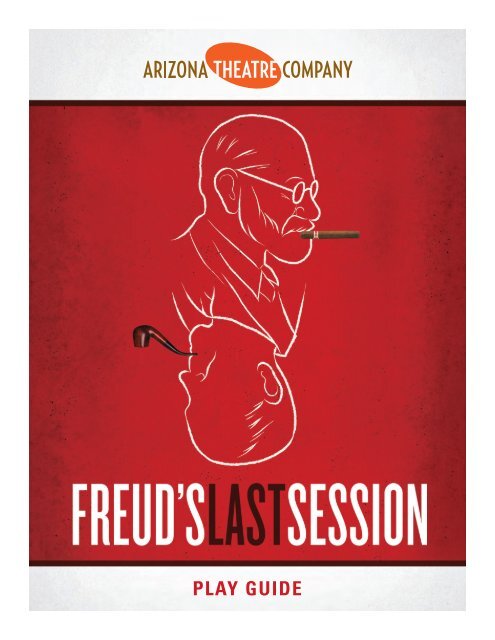
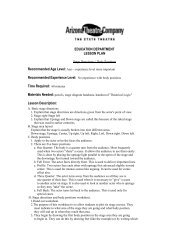


![Play Guide [356k PDF] - Arizona Theatre Company](https://img.yumpu.com/46218320/1/190x245/play-guide-356k-pdf-arizona-theatre-company.jpg?quality=85)
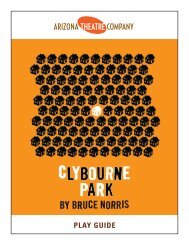
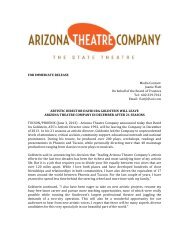
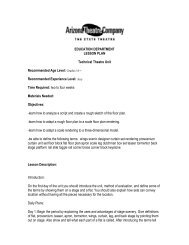

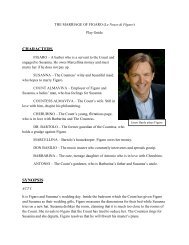
![[title of show] Arizona Theatre Company Play Guide 1](https://img.yumpu.com/24482689/1/190x245/title-of-show-arizona-theatre-company-play-guide-1.jpg?quality=85)
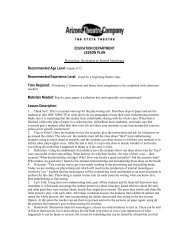
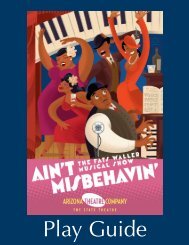
![Play Guide [1.2MB PDF] - Arizona Theatre Company](https://img.yumpu.com/11952176/1/190x245/play-guide-12mb-pdf-arizona-theatre-company.jpg?quality=85)
